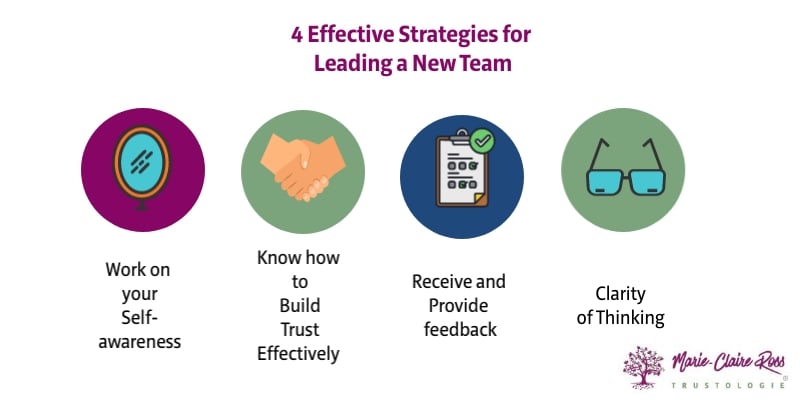
So you've just been elevated to the position of leading a brand new team - congratulations! No matter if this is your first time or you're a seasoned team leader, it's...
Over the years, I have asked many effective leaders managers to share some of their biggest leadership misconceptions before they began their leadership journey.
What became apparent for many of them was that these common misconceptions stopped them from fully embracing their leadership role, steering people confidently, understanding their unique leadership styles or even leading their team successfully.
The good news is that these common myths provided great learning opportunities when they reflected back on their progression.
Let's take a look at these common leadership misconceptions and what you can do to mitigate them.
Observing our superiors can sometimes lead us to question their performance. We may find ourselves critiquing their communication skills or clarity about business priorities, convinced that we could handle team management more effectively, given the opportunity.
However, it can be a rude awakening to discover the complexities of managing people and how much time and effort is required. New leaders are often surprised by how much of their work day goes towards helping others, leaving little time to get their own tasks done.
Another common misperception is that when you are a leader, you get to take it easy and tell people what to do.
The reality is much different. Leaders tell me that they were shocked to learn that their new leadership role can consume their personal life as well.
As one manager said to me "It's a 24 hour job. Always on your mind. Life happens. You get calls outside of work hours. It can be personal things. People will call me. It impacts them coming to work. So I'm available to them, if they have got stuff going on and need help working it all out."
As Bill Campbell, a famed company executive, once said, "Your title makes you a manager, your people make you a leader."
It can be easy to assume because you have landed a position as a leader on merit that you have what it takes to excel.
The truth is you need to learn how to lead and realise that you need to grow into the demands of the job. It's time to step up and fulfil your new leadership identity. Natural leadership abilities can only take you so far. Learning how to be a better leader is important, rather than assuming it will happen organically. This requires taking part in leadership development, in order to grow your leadership skills.
Of course, once your people follow you willingly, you know you are building leadership presence.
It's easy to think that if you're a good person, then people will see that, and respect your leadership. Unfortunately, being a leader means making the tough calls and decisions that not everyone will like.
Rather than being nice, you have to be kind. This means guiding your team members to do the right thing - whether that means calling out bad behaviours, giving constructive feedback or saying no. It means understanding the difference between being 'nice' and 'kind'. This often means making the tougher or kinder choice, that while it might mean people will initially dislike it, it is better for them and the company longer term.
A lot of new leaders fear pushback and that their team members, many who were their colleagues, will reject their leadership.
So they start leading people by checking in a lot and making sure they are okay. It means they are too afraid to make decisions, so their team get confused and frustrated. It can even become a self-fulfilling prophecy that people doubt a new leader's leadership ability, when they doubt it themselves.
The truth is you need to be true to yourself and not try to fit a mould or be the leader you think others want you to be. Authentic leadership requires knowing your leadership approach, believing in your leadership abilities and knowing that you will know what to do when the situation arises.
A common leadership development process when people start their leadership journey is to ask their direct manager for leadership tips. While this works well, if you have an effective leader as a boss, the reality is most leaders aren't aware of the variety of leadership skills available.
Not only that, the nuances of leadership mean a leadership approach might work for your boss, but can be totally inauthentic to your leadership style. What can surprise many new leaders is that their boss doesn't have the same emotional intelligence as them or relies on out-dated leadership skills
It can be easy to think your manager will teach you what you want to know, but if they haven't received extensive leadership training, coaching or had widespread experience, their advice can be limiting. It might even contradict with your values.
As one manager said to me, "I think being careful that you go under the right leader and they share your ideas about what leadership looks like. I had a command and control leader who didn't value my leadership approach. I did my best to create an amazing relationship with the boss. It didn't work out and I had to leave." Make sure you seek advice from a trusted advisor outside of your company or department, so you get a broader leadership perspective.
It's common leadership wisdom that people don't like change and that you can't change people. So it's easy to assume that you won't be able to convince people to change.
The truth is that people change at different speeds. This means that you need to change how you lead them and be more patient in their progress. You will find that some people accept change quickly, while others need more time to adjust. Learning to work with each individual to accept change is key.
If you are taking over a new team that has been without a manager for a while, or where job satisfaction is low, you can often think they are unhappy because they are overworked. You may even fear working with a team that seems so despondent.
We can never assume we know what's going on in a team, until we start working with them. The more we can work one-on-one with each individual and have conversations to work out how to improve the team, the more we can discover what the team needs.
The truth is what people really want is to be supported by their manager. They want to be valued, seen and heard. They want their new manager to understand their grievances, listen to their concerns and be there for them to remove bottlenecks.
Again, this sounds like a solid leadership theory, but what you will soon learn is that other people have different capabilities, perspectives, knowledge and work ethics.
Thinking that you can inspire others, the way you get inspired is a popular misconception that will stop you from being a successful leader.
As one team leader said to me, "I thought everyone was like me. That their mindset towards work was the same - you turn up, do what's asked and do your job. What I learnt when I got this role was that other people have different motivations as to what makes them enjoy their job and come to work each day." It takes an empathetic approach to work out how to get the best of each of your team members.
So many leaders fear having to call people out on poor behaviours and being ignored or even hated. They worry about destroying the relationship and the team going against them.
The truth is that it is much kinder to let someone know early that they need to improve their performance. It also means changing your mindset about having a "difficult conversation" to one that is about growing people's potential. What's important is that we learn to work with each person, being consistent in our approach and belief in them, to help them turn their performance around. You might be surprised by the results.
Embarking on the leadership journey to be an inspiring leader often uncovers the remnants of misguided beliefs and assumptions.
As a team leader, it's crucial to understand that there is no one-size-fits-all approach or ultimate best practice. What may have worked wonders one year could potentially fall short the next. The key lies in exploring diverse techniques and customising leadership strategies to suit the unique needs of each individual within your team. Just like you do with customers or your own children.
This entails a willingness to experiment with various methods and engage with team members on a personal level to ascertain what resonates best with them.
The truth is that the world is moving and adapting, and leaders need to evolve with it. Leaving our popular leadership misconceptions behind, that no longer serve us, is part of the process towards being a true leader.
If you want to learn more effective leadership skills, then take a look at the Tribe of Trusted Leader's 12 month development program to strengthen your leadership.

So you've just been elevated to the position of leading a brand new team - congratulations! No matter if this is your first time or you're a seasoned team leader, it's...

Leading oneself is the foundation upon which effective leadership is built. Without self-leadership, it becomes difficult to inspire and guide others towards shared...